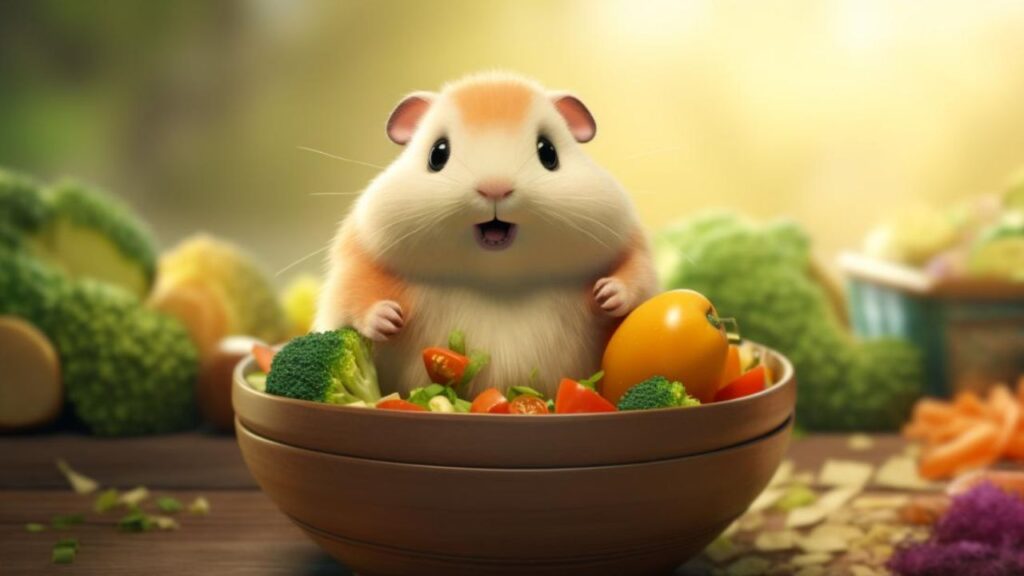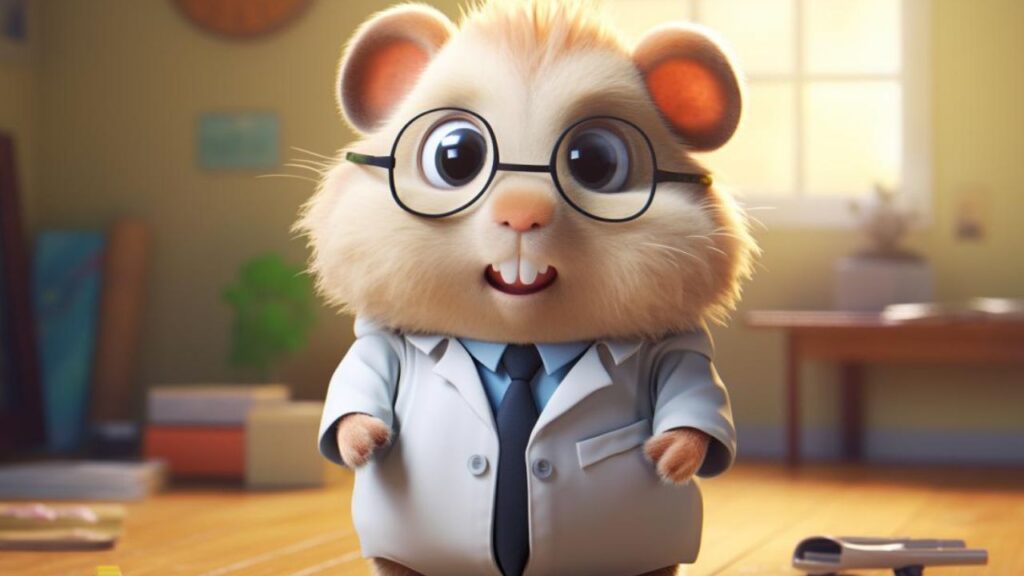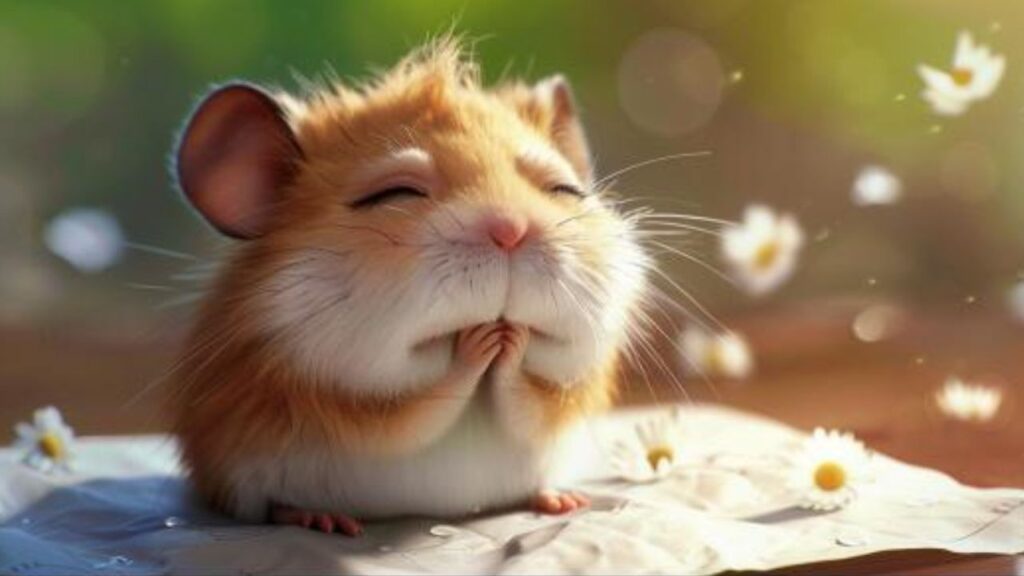Hello, my dear hamster caretakers! It’s your furry friend expert, Dr. Vivian Whiskerson, ready to whisk you away into the world of hamster happiness. Today’s topic is close to my heart: the importance of hamster enrichment. Let’s delve into how we can make our little buddies’ lives as joyful and fulfilling as possible!
Understanding Natural Behaviors: Learn What Makes Your Hamster Tick
Our little hamster friends have a whole host of natural behaviors that are just fascinating. In the wild, hamsters are busy little creatures – foraging for food, digging burrows, and exploring their environment. These instincts don’t vanish just because they’re in a cozy cage. By mimicking these natural activities, we can keep our hamsters engaged and content.
For instance, did you know hamsters are natural hoarders? They love to gather and store food, which is simply adorable to watch. Providing opportunities for them to forage and stash away treats in their bedding can really make their day. And let’s not forget their love for burrowing! A deep layer of bedding for digging can provide endless entertainment.
The Need for Stimulation: Why a Stimulated Hamster Is a Happy One
Just like us, hamsters need mental and physical stimulation to stay happy. A hamster without enough to do can become bored, and even depressed or anxious. Imagine spending your day in an empty room – not very fun, right? The same goes for our furry pals.
To keep their minds and bodies active, it’s important to have a variety of toys and activities in their cage. Think running wheels, tunnels, and mazes. These not only mimic their natural environment but also provide the necessary exercise and mental challenges they crave. Rotate these toys regularly to keep things fresh and exciting.
Signs of a Contented Hamster: Recognizing the Signs of Well-being
Now, how can you tell if your hamster is happy? There are several signs to look out for. A happy hamster is typically active, especially during the evening and night (as they are nocturnal creatures). They’ll be curious and eager to explore their cage, using their toys and exercise wheel frequently.
Another sign of happiness is a good appetite. A content hamster will eat regularly and have a healthy thirst. You’ll also notice regular grooming behavior, as hamsters take pride in keeping themselves clean.
Creating an Enriched Environment

My cherished hamster guardians! It’s time to roll up our sleeves and transform your hamster’s living space into a tiny paradise. An enriched environment is not just a luxury, but a necessity for our whiskered companions. Let’s dive into how we can create a habitat that’s not only safe but also brimming with joy and exploration opportunities!
The Ideal Home: Setting up the Perfect Habitat
The first step in creating an enriched environment is choosing the right cage. Size matters here, my dears. Hamsters need room to roam, play, and carry out their natural behaviors. A cage that’s too small can lead to stress and health issues. The bigger, the better – I always say aim for a minimum of 450 square inches of floor space.
Ventilation is another key factor. Wire cages are great for airflow, but remember to avoid large gaps to prevent escapes. If you opt for a glass aquarium, ensure it has a mesh top for adequate air circulation. The cage should be easy to clean, as a clean home is a happy home!
Place the cage in a quiet, but not isolated part of your home. Hamsters are sensitive to noise and temperature. They prefer a spot away from direct sunlight, drafts, and loud noises, which can cause stress.
Toys and Tunnels: Selecting the Best Accessories
Now for the fun part – toys and tunnels! These are not just playthings; they are vital for your hamster’s mental stimulation and physical exercise. A good, sturdy wheel is non-negotiable for those little legs to run on. Make sure it’s the right size and solid-surfaced to prevent injuries.
Tunnels and tubes mimic the burrows they would have in the wild. You can find various tunnel systems in pet stores, or get creative with PVC pipes. Chew toys are also important, as they keep your hamster’s teeth from overgrowing. Wooden blocks, untreated willow balls, and even cardboard pieces can work wonders.
Remember, variety is the spice of life. Rotate the toys regularly to keep your hamster intrigued and active. Just be sure all accessories are safe, non-toxic, and hamster-appropriate.
Safe and Cozy Nesting: Ensuring a Comfortable Resting Place
After all that playing and exploring, your little friend will need a cozy spot to rest. Nesting areas are crucial for a hamster’s sense of security and comfort. Provide a small box or hideaway where they can retreat for some peace and quiet. You can find adorable hamster houses in pet stores, or make one yourself from a small container with an entrance hole.
For bedding, avoid cedar or pine shavings, as the strong scent and oils can be harmful. Opt for paper-based or aspen bedding, which are safe and comfortable. Ensure the bedding is deep enough for burrowing – about 2-3 inches should do. And don’t forget to provide some nesting material, like unscented toilet paper or paper towels, for them to snuggle into.
Nutritional Nourishment

Greetings once more, my hamster-loving pals! Dr. Vivian Whiskerson here, ready to guide you through the delightful realm of hamster nutrition. Just like us, our tiny, furry friends need a balanced diet to stay healthy and spry. Let’s nibble our way through the essentials of hamster nutrition, ensuring our little ones get all the nourishment they need.
A Balanced Diet: What to Feed Your Hamster for Optimal Health
A hamster’s diet should be well-rounded, providing all the necessary nutrients. The foundation of their diet is a high-quality hamster pellet or mix. These commercial foods are formulated to meet their basic nutritional needs, offering a blend of grains, seeds, nuts, and vegetables. Avoid mixes with too many sunflower seeds or nuts, as they are high in fat.
In addition to pellets or mixes, fresh fruits and vegetables can be offered in moderation. Think leafy greens, carrots, cucumbers, or apples. However, it’s crucial to introduce these slowly and in small quantities to avoid digestive upset. Always wash fresh foods thoroughly to remove any pesticides or chemicals.
Fresh water is an absolute must, available at all times. A water bottle with a sipper tube is ideal to keep the water clean and accessible.
Healthy Treats: Snacks That Are Both Safe and Enjoyable
Now, who doesn’t love a little treat now and then? Hamsters certainly do! Treats should be given sparingly and be healthy for your hamster. Some safe options include small pieces of fruits like apples, pears, or berries. Vegetables like broccoli, cauliflower, or peas are also great choices.
You can also find commercial hamster treats, but be cautious with these. Some may contain high sugar or artificial ingredients, which are not suitable for your hamster’s health. Stick to natural, simple treats to keep your furry friend both happy and healthy.
Avoiding Harmful Foods: Foods to Keep Away From Your Hamster
Just as important as knowing what to feed your hamster is knowing what to avoid. Some foods can be harmful or even toxic to hamsters. Avoid onion, garlic, chocolate, caffeine, or any sugary or salty foods. Citrus fruits and almonds are also a no-go, as they can be harmful.
Also, steer clear of sticky or very hard foods that can be difficult for hamsters to eat. Remember, a hamster’s cheek pouches are sensitive and can easily be injured by sharp or sticky foods.
Exercise and Play

Welcome back, my hamster-loving companions! It’s Dr. Vivian Whiskerson here, ready to hop into the lively world of hamster exercise and play. Just like a sprinkle of joy in our lives, playtime and exercise are essential for our whiskered buddies. Let’s explore how these activities keep our hamsters not only fit but also gleefully engaged!
The Joy of Exercise: Why Physical Activity Is Vital
Physical activity is crucial for your hamster’s health and well-being. In the wild, hamsters cover large distances searching for food, so they are naturally inclined to be active. Exercise helps maintain their physical health, preventing obesity and related health issues. It also plays a significant role in mental health, keeping them stimulated and preventing boredom.
A well-chosen exercise wheel is the cornerstone of a hamster’s physical activity. Ensure the wheel is the right size for your hamster – their back should not bend when they run. Wheels should also be solid-surfaced to avoid foot injuries. You might even hear the gentle whirl of the wheel during the night – a sound of a happy, healthy hamster!
Interactive Playtime: Bonding Through Play
Playtime isn’t just fun; it’s a bonding opportunity. While hamsters are often seen as solitary creatures, they can form a bond with their human caregivers through interactive play. Gentle handling and play can build trust and provide essential mental stimulation.
You can engage with your hamster by gently letting them crawl over your hands and arms in a safe, enclosed space. Try setting up a play area outside the cage with tunnels and toys. Always supervise your hamster during these playtimes to ensure they are safe and secure.
Remember, each hamster has its own personality. Some may enjoy human interaction more than others. Always respect your hamster’s comfort level and never force interaction.
DIY Hamster Toys: Making Your Own Hamster Entertainment
Creating DIY toys can be a fun project and a great way to provide variety in your hamster’s life. Simple items from around the house can become exciting new toys. Here are a few ideas:
- Toilet Paper Roll Toys: Empty toilet paper rolls can be turned into tunnels, hideouts, or even stuffed with hay or treats for foraging fun.
- Cardboard Box Maze: Cut doorways in a series of small cardboard boxes and connect them to make a fun maze.
- Homemade Digging Box: Fill a sturdy box with hamster-safe bedding or play sand to create a digging paradise.
- Paper Bag Hideaway: A simple brown paper bag (without any ink or glue) makes a great rustling toy and hideaway.
Always ensure that any materials you use are safe and non-toxic for your hamster. Avoid anything with sharp edges, small parts that could be swallowed, or toxic substances.
Social Interaction and Mental Health

Hello again, my dear hamster enthusiasts! It’s Dr. Vivian Whiskerson, here to chat about a topic that’s as tender as a freshly baked cookie – the social interaction and mental health of our hamster friends. Understanding their unique personalities and needs is crucial for a fulfilling hamster-human relationship. Let’s delve into this heartwarming aspect of hamster care.
Understanding Your Hamster’s Personality: Every Hamster Is Unique
Just like us, each hamster has its own distinct personality. Some are bold and adventurous, while others may be shy and reserved. Observing your hamster’s behavior is key to understanding their personality. Notice how they react to different stimuli, their play preferences, and their sleeping patterns.
A hamster that eagerly explores its cage or runs to greet you might be more outgoing. In contrast, a hamster that often hides or startles easily might need a more gentle approach. Tailoring your interactions to match their personality helps in creating a comfortable and stress-free environment for them.
The Importance of Gentle Handling: Building Trust and Affection
Handling your hamster with love and gentleness is vital in building a bond of trust and affection. It’s important to let your hamster become accustomed to your scent and presence before attempting to handle them. You can start by feeding them treats from your hand to build familiarity.
When you begin handling your hamster, do so in a safe, quiet environment. Ensure your hands are clean and free of any strong scents. Approach them slowly and let them come to you. Scoop them up gently, supporting their entire body, and avoid sudden movements that might startle them. Consistency and patience are key – some hamsters may take more time to become comfortable with handling than others.
Recognizing Stress and Anxiety: How to Tell if Your Hamster Is Stressed and What to Do About It
Stress and anxiety can significantly impact your hamster’s health. Recognizing the signs of stress is essential for providing proper care. Signs of a stressed hamster include excessive grooming, aggression, hiding more than usual, or changes in eating and sleeping habits.
To reduce stress, first ensure their habitat is safe and comfortable. Avoid loud noises and sudden movements around their cage. Provide plenty of hiding spots and make sure their environment is not overcrowded with toys or accessories.
If your hamster shows signs of stress, try to identify the cause and make necessary changes. Sometimes, simple adjustments like changing the cage location, reducing handling, or providing more enrichment can make a big difference.
Health and Wellness Checks

Hello, my dear hamster caretakers! Dr. Vivian Whiskerson here, ready to guide you through the essential world of hamster health and wellness. Just like a gardener tends to their blooms, we must tend to our furry little friends with equal care and attention. Let’s delve into how regular health checks, understanding when to seek veterinary care, and maintaining grooming and hygiene can keep our hamsters in tip-top shape!
Regular Health Monitoring: Keeping an Eye on Their Well-being
Regular health monitoring is key to ensuring your hamster is thriving. This doesn’t require any medical expertise – just a keen, loving eye. Each day, take a moment to observe your hamster. Are they eating and drinking normally? Are their energy levels consistent with their usual behavior? Do they show interest in play and exercise?
Pay attention to their appearance as well. Their coat should be clean and well-groomed, not matted or unkempt. Eyes should be bright and clear, not cloudy or runny. And let’s not forget about those adorable little ears and the ever-twitching nose – they should be free of discharge or crustiness.
Monitoring your hamster’s weight is also important. Sudden weight loss or gain can indicate health issues. If you notice any changes or abnormalities in their behavior or appearance, it could be a sign that something’s amiss.
When to Visit the Vet: Recognizing Signs That Need Professional Attention
Even with the best care, there might come a time when professional veterinary attention is required. Knowing when to seek this help is crucial. Here are some signs that indicate a vet visit is necessary:
- Changes in Eating or Drinking Habits: A significant decrease or increase can be a sign of illness.
- Abnormal Discharge: Any discharge from the eyes, nose, or ears.
- Difficulty Breathing: Wheezing, labored breathing, or constant sneezing.
- Lethargy: If your hamster is less active or shows disinterest in activities they usually enjoy.
- Skin or Fur Problems: Bald patches, rashes, or signs of parasites.
- Changes in Bathroom Habits: Diarrhea or constipation.
Prompt veterinary care can make all the difference, so don’t hesitate to seek help if you notice any of these signs.
Grooming and Hygiene: Maintaining a Clean and Healthy Hamster
Grooming and hygiene are vital for a healthy hamster. Hamsters are naturally clean animals and often groom themselves. However, we can assist in keeping their living environment clean. Regularly cleaning the cage, ideally, once a week, helps prevent the build-up of harmful bacteria and keeps the habitat fresh and sanitary. Replace bedding and remove any soiled spots daily. For hamsters, bathing in water is a no-no as it can strip their fur of essential oils and cause stress. Instead, provide a sand bath. A shallow dish filled with chinchilla sand (not dust) allows them to roll and clean their fur naturally. Trimming nails might be necessary if they grow too long. If you’re not comfortable doing this, a vet or professional groomer can assist.
Community and Support

Hello once again, my hamster-loving friends! Dr. Vivian Whiskerson here, and today I’m excited to talk about a topic that’s as warm and fuzzy as our little hamster pals themselves – community and support. Whether you’re a seasoned hamster caretaker or new to the whiskered world, being part of a community can be incredibly enriching. Let’s scurry into how connecting with fellow hamster enthusiasts can enhance our experiences and deepen our understanding of these delightful creatures.
Joining Hamster Communities: Sharing Experiences and Tips
There’s a wonderful world of hamster communities out there, both online and in the real world. Joining a hamster community can be a rewarding experience, offering a platform to share and learn. From online forums and social media groups to local pet clubs, these communities are fantastic resources.
In these groups, you can share your own experiences and learn from others. Maybe you’ve found an ingenious way to keep your hamster’s cage fresh or discovered a toy that keeps your furry friend entertained for hours – these are the golden nuggets of wisdom worth sharing! Similarly, hearing about others’ experiences can provide you with new ideas and solutions to try.
Learning from Others: Gaining Insights from Fellow Hamster Owners
There’s so much to learn from fellow hamster owners. Each hamster is unique, and what works for one might not work for another. By engaging with the community, you can gather a wide range of insights and perspectives.
You might learn about different types of bedding that other owners have found success with, or get tips on how to handle a hamster who’s a bit on the shy side. Learning from others also means sharing in their challenges and successes, which can be incredibly comforting, especially if you’re facing similar situations.
Celebrating Our Hamsters: Sharing Stories and Successes
One of the most joyful aspects of being part of a hamster community is celebrating our little friends together. It’s a space where showing off your hamster’s latest cute antics isn’t just accepted, it’s encouraged! You can share photos, videos, and stories about your hamster’s quirky habits, milestones, and endearing moments.
Celebrating together strengthens our bond not only with our pets but also with fellow hamster enthusiasts. It’s a reminder of the joy and love these tiny creatures bring into our lives. From birthday celebrations to overcoming health challenges, every success, big or small, is worth sharing and celebrating.
In conclusion, becoming part of a hamster community offers support, learning, and a whole lot of joy. By sharing experiences, learning from others, and celebrating our furry friends, we enrich our journey as hamster caretakers. So, I encourage you to step into this warm and welcoming world. Share a story, ask a question, or simply soak in the adorable hamster content – together, we make the journey of hamster care a shared adventure filled with support and smiles. Until our next delightful chat, keep cherishing and celebrating your adorable hamster companions! 🐹💗🎉




